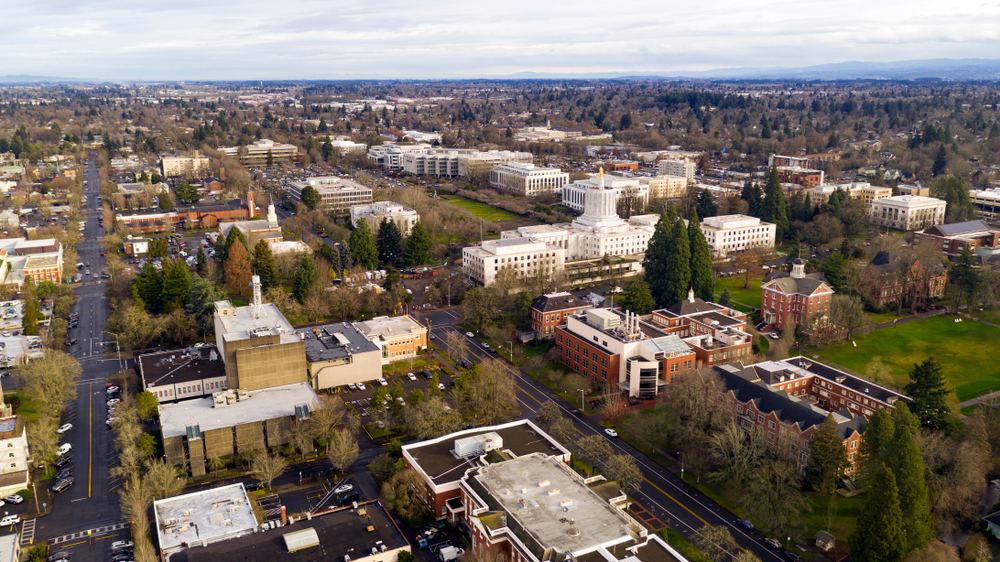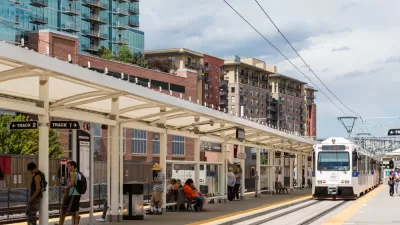The plans, they are a-changin.

The Building Envelope Expands, Along With the Planning Project of the 21st Century
More than any point in recent memory, planners are tasked with pointing cities and communities in a new direction.
An inescapable trend emerged in recent years and months: a large and growing number of communities are now engaged in comprehensive plans and zoning code revisions, and they're doing that planning work in the hopes of creating a future that is fundamentally distinct from the 20th century model of planning.
Comprehensive plans are expanding the vision of the urban centers of the future upward, not just outward. Instead of planning for more sprawl on the fringes of metropolitan areas and providing more protectionist measures for existing neighborhoods, plans are increasingly allowing for more room to grow inside city boundaries.
For years, it has been difficult to find examples of the building envelope or planned residential capacity of cities expanding except by means of annexation or greenfield development. With exceptions for central business districts and historic urban cores, plans in the largest cities usually meant protections for the single-family neighborhoods that comprise the vast majority of land uses in cities all over the country. New development at a scale to accommodate population growth was left to the fringes.
But in 2019, the number of cities allowing new kinds of urban-centered growth is quickly climbing. The number of states forcing urban growth on reluctant local governments is also climbing.
In these cities, affordable housing, missing middle housing, inclusionary zoning, transit oriented development, accessory dwelling units, and a mix of uses are valued over exclusionary zoning, euclidean zoning, greenfield development, parking requirements, and car-oriented master planning. New density, new building heights, and new incentives for transit oriented development and affordable housing are the orders of the day.
2019 might be the year that urban planning idealism is given a chance to overthrow the status quo.
The question of whether the new planning paradigms will be effective in undoing the worst consequences of 20th century planning is very much up for debate. Recent studies have generated skepticism that zoning for more density will balance the housing market. Others argue that we aren't going far enough, that "missing middle" housing won't suffice to solve the housing crisis. It's hard to say how many affordable units it will take to solve the housing crisis, but the scale required is certainly larger than the numbers discussed in the examples below.
Still, we know the legacies of the previous generation of plans: the congestion and environmental destruction of sprawl, the social inequality of exclusionary zoning, the decreasing supply of homes and apartments available at prices accessible to low- and middle-income people, and a massive, growing homeless population. And if the legacy if 20th century planning proves anything, it's that plans, and planning, and zoning matter—even if it's only one piece of a much bigger puzzle.
The status quo has fallen far short of its dreams. It would be foolish to assume a 20th century model will fit for the 21st century and beyond. If anything, an adjustment is long over due.
The plans, they are a-changin.
The Trendsetters
State of California

Last year's Senate Bill 827, which eventually failed in committee, shifted the new era of pro-development plans into a new gear. Building on the work of previous state legislation to make it easier to develop affordable housing and add accessory dwelling units, SB 827 and two other bills proposed by State Senator Scott Wiener attempted to make an unprecedented land use power group at the state level by ending density maximums, parking minimums, and restrictive height limitations for massive swaths of transit adjacent areas around the state.
SB 827 failed, but Senator Wiener and the state's growing number of Yes In MY Backyard (YIMBY) advocacy organizations haven’t given up. Wiener proposed a new bill, SB 50, which proposes many of the same pro-development reforms, and Wiener is now chairing the committee that killed SB 827 in 2018.
The California State Legislature this year will also consider a bill called the Housing Crisis Act of 2019, otherwise known as SB 330. Proposed by State Senator Nancy Skinner (D-Oakland), SB 330 would "curtail the ability of cities and counties to rezone properties to decrease their developable potential," according to a February 21, 2019 article by Steven Sharp.
Minneapolis, Minnesota
Building on the effort of SB 827 in California, the Minneapolis 2040 Comprehensive Plan has probably done more to move the needle on planning for new density than any other effort around the country. While an earlier draft of the plan called for fourplexes in every residential neighborhood in the city, the final, approved plan dialed the density back a notch to allow for triplexes—a massive shift in the planning paradigm and a major accomplishment for the city's planners and politicians. Now that the plan is approved, the implementation of zoning changes will probably still pose challenges, so Minneapolis will remain a city to watch for the foreseeable future. The Neighborhoods 2020 plan, for instance, is in the works now, with the intention of diversifying the city's neighborhood organizations.
Los Angeles, California
Evidence of the state of California's effectiveness is jumpstarting accessory dwelling unit (ADU) construction is most obvious in Los Angeles, where according to a study by the Terner Center for Housing Innovation at UC Berkeley, ADU permits jumped from 90 ADU applications in 2015 to 1,980 in 2017.
But for a homegrown approach to the new planning paradigm, look no further than Measure JJJ, approved by city of Los Angeles voters in 2016 and already having a tangible effect on the built environment. Measure JJJ enabled the Transit Oriented Communities Affordable Housing Incentives Program, which is designed to create more of two things: affordable housing and transit oriented development.
Based on analysis by Craig Lawson and Jason Lopata published in September 2018, the city had received applications for 112 TOC projects as of June 2018, yielding 5,571 residential units, with 1,145 affordable units set aside in that total. A Los Angeles Department of City Planning report from earlier in 2018 also touted the program's success in delivering affordable units.
In 2017, Los Angeles voters were also faced with an aggressive ballot measure, "The Neighborhood Integrity Initiative," that would have slowed growth considerably by giving new discretionary powers to the public. Voters soundly defeated that measure.
States Take Control
The State of Oregon

The state of Oregon is considering two bills that would make a significant departure from the planning status quo by enabling new density in cities throughout the state. Although these bills have a long way to go still for approval, the actions of the state of Oregon represent the most ambitious rejection of the status quo of 20th century planning paradigms underway anywhere in the country.
House Bill 2001 would follow the lead of the Minneapolis 2040 comprehensive plan by ending single-family zoning in all Oregon cities of at least 10,000 residents. The bill, proposed by House Speaker Tina Kotek (D-Portland), requires cities to allow fourplexes on properties currently zoned for single-family zoning. The statewide scope of House Bill 2001 distinguishes it from its predecessors. If approved, it would instantly become a landmark law in the history of long-term planning in the United States.
Then there's Senate Bill 10, recently proposed by Oregon Senate President Peter Courtney (D-Salem), which would mandate statewide increases in density around frequent transit lines. Senate Bill 10 provides another example of a state considering whether to override local control of land use regulation, similar to House Bill 2001 and the famous example provided by SB 827 in California in 2018.
State of Utah
Utah State Senator Jake Anderegg, R-Lehi proposed SB 34, an "Affordable Housing Modifications" bill for consideration by the State Legislature this year.
In addition to increasing funding for the state's largest affordable housing loan fund, SB 34 would allow mother-in-law apartments and encourage construction of high-density housing near transit in the hopes of promoting housing affordability (for more details on the proposed legislation, see news coverage by Tony Semerad from December 2018).
As noted by an article by Nolan Gray and Brandon Fuller, SB 34 would force local governments to plan for the state's worsening housing crisis. But unlike proposed laws in California and Oregon, SB 34 leaves much of the legal control of land use regulations in the hands of local governments. It will still be up to cities how they go about achieving their plans for growth.
"Municipalities facing a housing crunch would have to adopt at least three policies from a menu of popular housing reforms—policies that run the gamut from bread-and-butter housing policy to radical reforms. More conservative options, like starting a community land trust or purchasing and preserving existing affordable units, are still on the table. So, too, are permitting accessory dwelling units and lowering parking requirements," according to Gray and Fuller.
State of Washington
In addition to Oregon and California, the state of Washington will be one of the most active in considering statewide legislation that could change the land use regulatory system is cities and communities of all shapes and sizes and every corner of the state.
Headlining the effort is State Senator Guy Palumbo (D-Maltby), who has proposed a package of housing bills that are driving the land use and planning discussion in the state (the comparison to Senator Scott Wiener in San Francisco has been made more than once). As explained in an article by Josh Cohen, published in January 2019, Cohen is proposing one bill that would require "minimum densities of 150-units of housing per acre within a half-mile of a transit hub," and another that would "make 'missing middle' housing, such as duplexes, triplexes, small apartment buildings and the like, legal to build near public amenities, such as parks, schools and hospitals." Doug Trumm also provided coverage of the minimum density bill when it was still gestating at the end of 2018.
Local control advocates are not pleased with the idea of the state calling the density shots, but Palumbo defends the need for state preemption by describing mistakes made by planners and politicians 20 years ago. Here is Senator Palumbo, quoted in Cohen's article:
My district is the epicenter of the growth issues not happening as intended over 20 years ago when we passed the Growth Management Act. You have Seattle not upzoning, but people have to buy homes somewhere. We take growth from Seattle, but don’t get investment in roads, schools, transit. The lack of density in cities is breaking my district.
Palumbo isn't the only Washington legislator active in the land use and housing discussion this year. Stephen Fesler published a long list of bills to watch this year in those fields as well as the environment, transportation and infrastructure, and public safety.
Locals Trying to Undo the Consequences of Past Planning Paradigms
Charlottesville, Virginia

Charlottesville, Virginia is working on a Comprehensive Plan that includes a new land use map that would allow higher-density housing around the city. The Comprehensive Plan is proposing new density as a prescription for recent racial strife, and a history of land use powers skewing toward wealthy, white interests.
Caris Adel wrote a feature published in January about how the density proposed in the Comprehensive Plan has emerged in response to a legacy of inequality resulting from decades of neighborhood associations wielding land use power in the name of neighborhood character.
Unable to grow outward, advocates won't allow advocates from wealthy white neighborhoods to direct growth only to a few corners of the city any longer.
"In the past, Charlottesville’s growth has been warped, with development directed toward a handful of neighborhoods while others remained untouchable. This continued even as late as 2003, says Planning Commission member Rory Stolzenberg, when the city moved to promote higher-density development in the West Main Street corridor," according to Adel.
The historically African-American neighborhoods like 10th and Page and Fifeville have done the heavy lifting of absorbing the city's new development and growth, at the potential expense of neighborhood character. "Black neighborhoods, meanwhile, have historically been ignored, displaced, and overruled. In a 1995 oral history of the Ridge Street neighborhood, longtime black residents Joan and Theresa Woodfolk recounted a pattern of neglect by the city, and described feeling as if they had to beg for basic services," according to Adel.
As detailed by Adel, planners are pushing for more density to increase the stock of affordable housing in the city, reduce the exclusionary realities of single-family zoning, reduce segregation in the city, and better represent the needs of renters in the community. A separate article by Emily Noko describes the Compressive Plan as an effort to fight back against the city's racist zoning demons.
Despite the intentions of the narrative, and the relatively advanced stages of the planning process, the density proposed in the current Comprehensive Plan is far from a sure thing.
San Diego, California
Andrew Keatts reports that San Diego Mayor Kevin Faulconer asked the City Council "to eliminate building height limits near transit throughout the city, outside of coastal neighborhoods" in a state of the city address earlier this year. The mayor also suggested removing parking minimums and allowing new density for affordable housing development. The mayor has already proposed a law to rescind parking requirements in transit-adjacent neighborhoods.
"Faulconer announced the plan while explicitly framing himself as a YIMBY – for Yes in My Backyard – a term positioned against so-called NIMBYs who oppose new development. He declared himself the city’s first YIMBY mayor," according to Keatts.
The mayor's YIMBY politics directly counter the protectionist policies advocated by neighborhood groups over the last century or so of local planning politics, sometimes called NIMBY politics, for Not in My Backyard.
According to Keatts, if the San Diego City Council were to adopt the planning and zoning package proposed by Mayor Faulconer, San Diego would be "among the most aggressive [cities] in the state at attacking California’s housing shortage."
Fairfax County, Virginia
The Fairfax County Board of Supervisors in March 2018 approved the Embark Richmond Highway plan, which allows for new density on an eight-mile stretch of the Richmond Highway (also known as U.S. Route 1). The new density in the area around the Huntington Metro Station complements the larger Richmond High Corridor Improvements project and a Richmond Highway Bus Rapid Transit (BRT) plan that will expand the highway and add BRT, bike, and pedestrian infrastructure.
Here we see density as a key component of transportation planning—the long-promised and seldom-delivered intersection between land use and transportation planning.
An article by Joanne Tang from January 2019 details the plans for the transit gateway around the Huntington Metro Station.
Santa Rosa, California
"Developers seeking to build housing developments near Santa Rosa’s two train stations could soon build up to twice as many market-rate apartments as would otherwise be allowed by promising to construct additional affordable housing," reported Will Schmitt in January 2019.
"The move is the latest step in a series of changes meant to make the city more attractive to builders as it starts to overhaul its long-term blueprint for downtown commercial and residential development," according to Schmitt.
The new density bonus was necessary to comply with a new state law (see the above section on California). Still, Santa Rosa's new density bonus takes the city beyond compliance with state law.
Seattle, Washington
The city of Seattle is currently working to deliver the unzoning promised by the Mandatory Housing Affordability (MHA) policy approved by the city several years ago, and in development in the years since. According to a recent article by Daniel Beekman, "the plan would upzone 27 urban villages, plus commercial corridors and about 6 percent of lots now zoned exclusively for detached houses."
The process of upzoning the targeted areas of the city has created political controversy all over the city, in the University District for instance, and for the City Council in particular. Supporters of the upzonings were marshaling resources to bolster the plan as recently as February 21, 2019.
In case the upzonings of the MHA plan fall short of the original intention, the city can still take credit for approving a fairly broad and consequential parking reform package in April 2018.
Spokane, Washington
Rebecca White reported on January 8, 2019 that the city of Spokane, Washington is considering changes to its zoning code that would allow taller developments and fewer parking regulations in parts of its downtown.
"City Council President Ben Stuckart said the regulations, which allow 30 to 50 percent less parking on attached housing and dwellings to be built about 15 feet taller, were a few of several potential rule changes designed to fill in sections of the city and combat a housing shortage," according to White.
"Loosening the restrictions on parking, building height, lot size and other standards could encourage developers to build duplexes, townhouses or attached houses, which are sometimes called row houses," according to Nathan Gwinn, an assistant planner at the city of Spokane, who is paraphrased in the article. Gwinn is describing the missing middle of housing—another notable theme emerging from contemporary planning efforts.
Renton, Washington
In fact, missing middle housing is the main talking point driving new allowances for accessory dwelling units in Renton, Washington.
"Faced with its own need for middle-income or 'workforce' housing, the Renton City Council voted in October 2017 to cut ADU permit fees in half. Based on the modest success of the program so far — over the past year there were five applications for new ADU permits versus five total between 2010 and 2017 — the city council voted in mid-November to extend the fee cuts [pdf] until the end of 2020," wrote Josh Cohen in December 2018.
Salt Lake City, Utah
Salt Lake City relaxed its zoning code to allow for accessory dwelling units in October 2018. According to an article by Tony Semerad, the city previously allowed ADUs only within a half-mile of transit stops on the TRAX system. The changes to the city's ADU regulations now allow for ADUs in residential neighborhoods citywide.
"The city’s new approach also eases some requirements on entrances and setbacks for ADUs, as well as rules for parking by letting driveways and available street parking spaces suffice," explained Semerad at the time of the approval.
Semerad's portrayal of the political debate surrounding the debate broke down on the expected political lines: on one side, advocates for housing affordability, on the other, residents concerned about parking and "quality of life."
Cedar Rapids, Iowa
B.A. Morelli reports that the Cedar Rapids City Council approved an overhaul of the city's zoning code in December 2018.
"The old code was written in the spirit of the 1950s and ’60s when suburban development took precedent over downtown neighborhoods, but the city has grown and tastes have changed and in some case come full circle," according to Morelli.
Included in those new tastes are new allowances for accessory dwelling units, bike parking, and urban bee keeping. Interestingly, the city decided to reduce the former code's emphasis on ground floor retail or commercial spaces in the city's downtown urban core. "Under the new code, the city is moving away from that requirement and letting the market dictate except for on Third Street SE and 16th Avenue SE between NewBo and Czech Village," according to Morelli.
The stated purpose of the city's new zoning code is to enable a more walkable and bikable city, in keeping with the vision laid out in the city's 2015 EnvisionCR Comprehensive Plan. The new code is also a form-based code, as detailed in an article by Morelli from 2016.
The Cautionary Tales
San Francisco, California

The City by the Bay provides a complicated case study of progressive planning efforts in 2019.
On one hand, ambitious measures with broad support from the pro-development and urbanist coalition have been achieved or underway in the city. At the end of 2018, the city achieved the highest-profile example of parking reform in the country, when the San Francisco Board of Supervisors decided to eliminate parking minimums citywide. Since then, the city's newly-elected mayor, London Breed, has proposed by-right approval of affordable housing developments, as well as reduced development fees for affordable housing.
On the other hand, the city's aggressive approach to inclusionary zoning has been criticized as too much of a hindrance for developers and case study in unintended consequences.
Also on the other hand, the city also approved the massive Central SoMa Neighborhood Plan in November 2018. The first lawsuit against the plan has already been filed, under the accusation that the plan does not sufficiently consider the impacts of 39,000 new jobs and 7,000 new homes on the city's infrastructure. That litigation reflects the traditions of the old planning paradigm. But YIMBYs and urbanists also protested the Central SoMa plan's jobs-housing imbalance, arguing that the development patterns proposed in the plan will ensure a continued reliance on long automobile commutes.
San Francisco has as much reason as any city to get the new era of planning right—the city has become a poster child for many contemporary urban ills, like failing public transit, the persistence of car culture, skyrocketing housing prices, gentrification and displacement, and corporate interest being allowed to run roughshod over the independent spirit and small business entrepreneurialism of urban centers.
New York, New York
Finally, there's the Big Apple. Like San Francisco, it's hard to get a sense of how committed New York is to maximizing its urban potential. Granted that it would be foolish to argue that New York City hasn't gone much further along this road than any other city in the United States. Along the way, New York also became the poster child of the perceived ills of urban growth—from slum clearance to broken windows to gentrification and displacement.
Mayor Bill de Blasio has been spearheading a series of rezonings around the city, aimed at increasing the city's housing stock, preserving existing affordable housing units, and adding new affordable housing units to achieve an ambitious housing platform laid out at the beginning of his first term.
Under the banner of two programs approved in 2016, Zoning for Quality and Affordability and Mandatory Inclusionary Housing, the New York City Department of City Planning has managed to complete extremely controversial rezonings of neighborhoods in all five boroughs. The two programs' list of planning reforms included reads like a progressive's wish list, including parking reform for numerous building types along transit lines.
The controversies surrounding these rezonings, the continued lack of affordable housing, rising housing prices, falling transit ridership, and public squabbles with the Trump administration earn skepticism about whether New York's planning efforts are heading in the right direction, and as always, New York will be one of the first places to look in the future to determine the success of the present.

Planetizen Federal Action Tracker
A weekly monitor of how Trump’s orders and actions are impacting planners and planning in America.

Chicago’s Ghost Rails
Just beneath the surface of the modern city lie the remnants of its expansive early 20th-century streetcar system.

San Antonio and Austin are Fusing Into one Massive Megaregion
The region spanning the two central Texas cities is growing fast, posing challenges for local infrastructure and water supplies.

Since Zion's Shuttles Went Electric “The Smog is Gone”
Visitors to Zion National Park can enjoy the canyon via the nation’s first fully electric park shuttle system.

Trump Distributing DOT Safety Funds at 1/10 Rate of Biden
Funds for Safe Streets and other transportation safety and equity programs are being held up by administrative reviews and conflicts with the Trump administration’s priorities.

German Cities Subsidize Taxis for Women Amid Wave of Violence
Free or low-cost taxi rides can help women navigate cities more safely, but critics say the programs don't address the root causes of violence against women.
Urban Design for Planners 1: Software Tools
This six-course series explores essential urban design concepts using open source software and equips planners with the tools they need to participate fully in the urban design process.
Planning for Universal Design
Learn the tools for implementing Universal Design in planning regulations.
planning NEXT
Appalachian Highlands Housing Partners
Mpact (founded as Rail~Volution)
City of Camden Redevelopment Agency
City of Astoria
City of Portland
City of Laramie





























